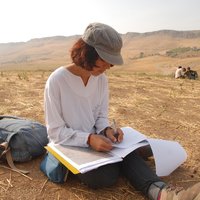Zahra Hashemi
Musée du Louvre, Paris, Département des Antiquités Orientales, Faculty Member
- -edit
Research Interests:
A graveyard at Baba Jilan in Dilfan province, Pish-i Kuh, Luristan, was reportedly looted in 2005. It was investigated by the local branch of the Cultural Heritage, Handicrafts and Tourism Organisation from 2006 to 2008. Cist tombs and... more
A graveyard at Baba Jilan in Dilfan province, Pish-i Kuh, Luristan, was reportedly looted in 2005. It was investigated by the local branch of the Cultural Heritage, Handicrafts and Tourism Organisation from 2006 to 2008. Cist tombs and jar burials were discovered and isolated objects and sherds were collected from the plundered areas. Noteworthy among these are a Luristan iron mask pommel sword, the first ever-provenanced sword of this type, and a bronze fingerring with the image of Ahura Mazda in a winged circle. These finds suggest that the area may have been used as a graveyard from the late Iron Age II onwards.
Research Interests:
in archaeological terms, Central Zagros is known as "Cultural Luristan" including present-day provinces of Luristan and Ilam as well as southern parts of Hamedan and Kermanshah provinces. According to folklore, Cultural Luristan is... more
in archaeological terms, Central Zagros is known as "Cultural Luristan" including present-day provinces of Luristan and Ilam as well as southern parts of Hamedan and Kermanshah provinces. According to folklore, Cultural Luristan is consisted of Pish-i Kuh and Pusht-i Kuh separated by the mount Kabir Kuh located on the east and west of the mountain, respectively. Luristan is mainly known for a set of metal objects made of bronze, iron and silver found in the region since 1930s and soon became widespread in the antique markets, museums, and private collections worldwide and well-known as "Luristan Bronzes". Shortly after publication of first scholarly reports about the Bronzes of Luristan, illegal excavations sharply increased in Cultural Luristan and resulted to mass plundering of archaeological heritage of the region. Among first scholars that published their thoughts about the bronzes of Luristan are A. O. Pope, A. Godar, and Schaffer. Later on, several archaeological expeditions such as the Belgium archaeological team at Pusht-i Kuh and the American Holmes expedition at Pish-i Kuh conducted field investigation mainly in search of origin of the Luristan bronzes and in the hope of resolving their enigma. Recently, new data and material came from excavations at Sangtarashan, Baba Jilan, and Zagros graveyard providing invaluable insights into the archaeology pf Luristan Bronzes. However, questions such as the place and the technique of manufacturing, identity of manufacturers, their function, and so on are among unresolved mysteries of the Bronzes of Luristan that have to be addressed in future researches.
Research Interests:
Research Interests:
Research Interests:
Research Interests:
Research Interests:
A graveyard at Baba Jilan in Dilfan province, Pish-i Kuh, Luristan, was reportedly looted in 2005. It was investigated by the local branch of the Cultural Heritage, Handicrafts and Tourism Organisation from 2006 to 2008. Cist tombs and... more
A graveyard at Baba Jilan in Dilfan province, Pish-i Kuh, Luristan, was reportedly looted in 2005. It was investigated by the local branch of the Cultural Heritage, Handicrafts and Tourism Organisation from 2006 to 2008. Cist tombs and jar burials were discovered and isolated objects and sherds were collected from the plundered areas. Noteworthy among these are a Luristan iron mask pommel sword, the first ever-provenanced sword of this type, and a bronze fingerring with the image of Ahura Mazda in a winged circle. These finds suggest that the area may have been used as a graveyard from the late Iron Age II onwards.
Research Interests: Iron Age and Luristan
Research Interests: Iron Age and Luristan
